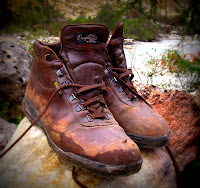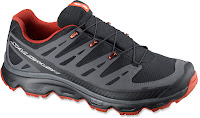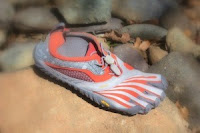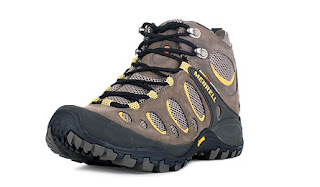 |
| The right hiking boots are the means to many memorable miles |
50 years ago, the "choice" was pretty basic - full leather hiking boots with aggressive lugs on the sole. There wasn't really anything else on the market. However, since that time not only have the number of options burgeoned, so have the number of categories of hiking footwear - so how do you navigate the increasingly congested waters of outdoor footwear?
The best place to start is to figure out what kind of trekking or outdoor activities you will be participating in most - Day hikes? Thru-hike? Trail running? Mountaineering? Once you figure that out, you will be able to narrow down which category of shoe/boot is the best for you.
While categories of outdoor footwear are by no means universally agreed on, the following four help give an idea of the spectrum:
In addition to determining your level of activity, there are also considerations such as construction and special features - waterproof, special lacing systems, sole construction, ankle support, etc.
 |
| Salomon Synapse trail shoe with Quicklace |
Gore-Tex and eVent have built reputations as the best and most reliable waterproofing technologies, but many companies are coming up with their own proprietary waterproofing, such as B-DRY (Oboz), Keen.Dry (Keen), and Climashield (Salomon).
There are also options for sole construction - Vibram is well known and used by a number of companies, but many companies use their own technology. Lacing systems are pretty standard, though quick-lace systems like Boa and Salomon's Quicklace laces are also options.
So, with all of these ideas bouncing around let's look at the four categories of outdoor footwear:
1. Trail Runners - Within trail runners (or hiking shoes) there are two main subdivisions - minimalist and standard trail runners.
- Minimalist shoes have jumped on the scene with incredible popularity over the last 5 years. Makers such as Vibram and Merrell have come out with trail versions of their minimalist shoes, designed to stand up to the more rugged demands of off-road running and hiking. However, these shoes are not designed for long hikes and are more for specialty running.
- Standard trail runners are usually built on a normal shoe platform and "beefed up" with more aggressive tread patterns for traction on non-paved surfaces and given reinforced uppers to slow wear-and-tear. These tend to be the most comfortable out of the box and can carry the wearer for miles on uneven trail. These are great for occasional trail hikers or folks who want to run rather than hike trail. However, the less rigid sole construction will contribute to arch fatigue faster than boots if worn for substantial distances.
 |
| Vibram's trail minimalist - Fivefinger Spyridon LS |
2. Light Hikers/Hybrids - This category is somewhat of a catch-all: everything built on a boot platform that is not an all out backpacking boot. Some will fall closer to trail shoes, while others will almost be backpacking boots.
 |
| Merrell's Chameleon EVO mid is a great light hiker - comfortable and durable |
Generally, the shoe's upper will be a combination of leather, or some other durable material like Cordura, together with sections of mesh and padding to increase breathability and decrease break-in time, while giving up only a minimum of durability.
Since most hikers are not out 5 days a week, nor are they tackling major miles on any one trip, light hikers and hybrids have become the most popular, and the most prevalent, hiking footwear option. Ankle height and torsional rigidity (how easily you can bend/twist the sole) are important indicators of how a light hiker/hybrid will protect against ankle sprains - make sure to test each option before buying by wearing it around the store and on a slope (many outdoor retailers will have some sort of simulated slope to try shoes out on), as well as torquing the sole to test the rigidity.
3. Backpacking Boots - Backpacking is generally the same as hiking, with one exception - you are carrying a pack. The added weight of a pack necessitates that backpacking boots be able to support more weight, as well as giving additional support to the feet that are carrying that weight. As a result, backpacking boots tend to have more robust soles and more rigid uppers.
One positive by-product of this need for added stability is that backpacking boots are generally very durable and can easily last 5-10 years, or even longer.
They are a great option even for recreational hikers if you are willing to go through the break-in period - backpacking boots usually take time to break in, varying depending on how they are made and how you choose to break them in.
They are a great option even for recreational hikers if you are willing to go through the break-in period - backpacking boots usually take time to break in, varying depending on how they are made and how you choose to break them in.
Usually, the best choice for breaking in backpacking boots is to wear thick socks and go for a series of short hikes (1-4 miles) or just walk around wooded areas. Choosing to wear brand new backpacking boots on a long hike without breaking them in is an almost guaranteed way to a) get blisters, b) get bruises, and c) be miserable, but once they are broken in they will be faithful companions for years to come.
 |
| Mountaineering boots and crampons |
A final word, on fit - when it comes to footwear, the fit should be the number one deciding factor. It doesn't matter if they look great if they leave you with bruises halfway through your hike; getting a great deal on them is pointless if they give you blisters every time you leave the house.
The two most important places to check fit are:
- The heel cup - If your heel does not sit nice and snug in the heel cup, specifically if it rises out of the cup, heel blisters and bruises to the Achilles tendon will likely occur on longer hikes. Walking up an incline is good way to test the heel cup.
- The toe box - There should be enough room in the toe box that the toes do not strike the front of the shoe/boot, which will cause bruises under the toe nails. Walking down a decline is a good indicator of whether your feet will slide. Buying a half-size bigger is often a wise choice.
Find the right footwear and get out and find your next trail!

No comments:
Post a Comment